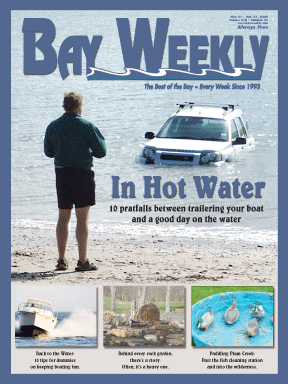
Volume XVII, Issue 21 # May 21 - May 27, 2009 |
 |
Letter From the Editor
Back to the Water in Pleasure and Policy
Memorial Day ushers in summer, bringing Bay Weekly back to the water with a collection of cautionary stories for pleasure boaters who might, in their eagerness to get out, have forgotten the dangers of the Chesapeake and the challenges for small craft that carry us out on those waters — and sometimes home safely.
I’m always surprised by how much I’ve forgotten over winter, so these stories are a refresher course for me — and I hope for you. Writers — especially Allen Delaney — have wrapped their message in humor, so reading them will be its own pleasure.
I wasn’t laughing when I assigned them — after both nearest neighbor boats at my marina got towed back in to end their first cruise.
We’re back to the water in another way as well, with last week’s revival of hope for improving the health of the Bay. Huge promises have just been made at the state, regional and national level.
At the regional level, the Chesapeake Executive Council kicked itself and Bay restoration into a new gear, deciding that setting a series of short-term goals could help get us to the longer-term goals we’ve been missing. That action means all of the big Bay partners — Virginia, Pennsylvania, D.C., and the EPA, as well as Maryland — have got to start making progress right now to show achievement by 2011 — and all the way to 2025.
In Maryland, Gov. Martin O’Malley promised to go the Council five years better, achieving our big nitrogen-reduction goal by 2020. We’ll get there, he said, in two-year jumps, measured by his BayStat accountability program. The first two-year’s goals include:
• Doubling our cover crop program;
• Expanding forested buffers and wetlands on both public and private lands;
• Retrofitting stormwater on over 90,000 acres;
• Upgrading over 3,000 septic systems;
• Upgrading several sewage treatment plants to Enhanced Nitrogen Removal; and
• Reducing nitrogen deposition from our power plants via the Healthy Air Act.
At the same time, in Washington, President Barack Obama issued an executive order on Bay restoration. His description of the Chesapeake as “a national treasure” could go a long way toward putting the faltering restoration plan back on track.
The order empowers the Environmental Protection Agency to establish a more demanding timetable and, presumably, to penalize Bay states that lag in playing their part in the cleanup.
Also significant is having Chuck Fox — who’s been a Bay champion in state government and in powerful advocacy organizations — as an EPA overseer.
What remains to be seen is how far the administration will go in tackling the core problems: farm pollution and the antiquated sewage treatment plants pumping out Bay-choking nitrogen. Both involve vast spending: grants for modern technology to handle treatment and incentives for farmers, both row-crop and chicken producers, to change their habits. The agriculture lobby remains strong in Washington, and Obama does come from a farm-rich state.
It won’t be easy, or cheap.
This week, we saw a positive sign when the Obama administration announced its new fuel-efficiency rules for autos and trucks that will dramatically improve mileage by 2016 (to an average 351⁄2MPG) and reduce tailpipe emissions.
Scientists believe that as much as a third of the nitrogen entering the Chesapeake comes from air pollution that lands in the water or on the land around it, where it runs into the Bay.
Then again, from every level, we’ve heard such promises before.
So enjoy our tips for boating safety — and keep an eye on those promising a cleaner Bay for your smooth sailing.